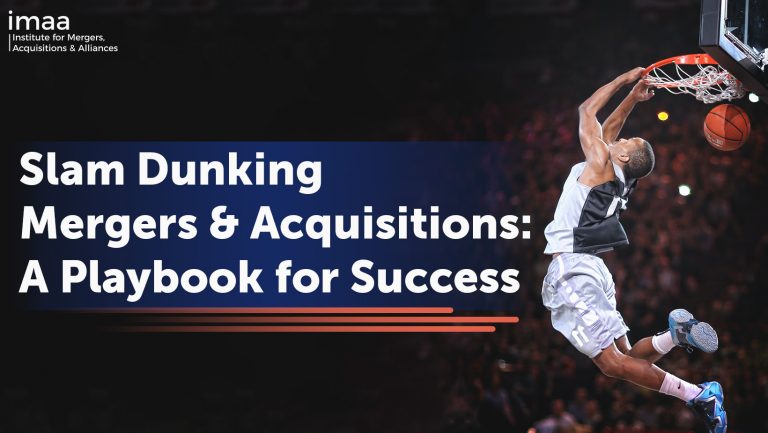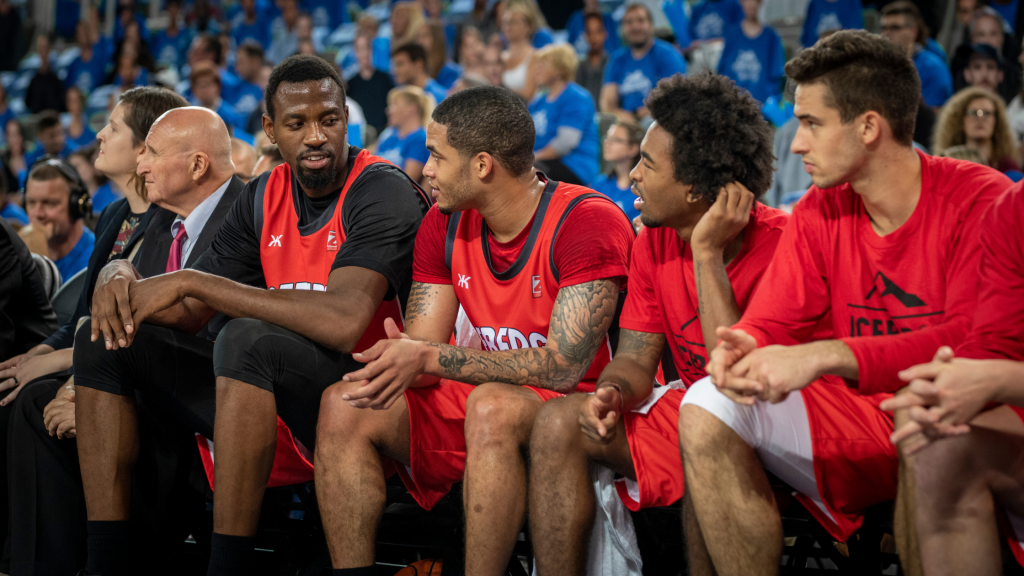
Blog Slam Dunking Mergers and Acquisitions: A Playbook for Success
- Blog
Slam Dunking Mergers and Acquisitions: A Playbook for Success

SHARE:
In the realm of corporate dealings, mergers and acquisitions (M&A) can frequently appear as a high-stakes competition where businesses vie to surpass their competitors. Interestingly, the world of basketball offers a rich source of comparisons, vocabulary, and tactics that can be adapted to M&A. Be it spectacular slam dunks, swift fast breaks, or well-executed assists, the connection between basketball and M&A runs deeper than one might initially realize. Within the following article, the exploration will unfold on how the principles, strategies, and jargon of basketball can be leveraged to enrich comprehension of the M&A process.
Overview
- The Game Plan: Strategy and Preparation
- The Fast Break: Speed and Timing
- The Dunk: Making a Bold Move
- Blocking Dunks: Defending Your Turf
- The Pivot Point: Maneuvering Challenges
- Dribbling: Maintaining Control
- The Assist: Collaborative Efforts
- The Brisk Drive: Momentum and Initiative
- The Three-Point Shot: Long-Term Strategy
- The Buzzer Beater: Timing the Deal Closure
- The Half-Court Press: Strategic Defense
- The Zone Defense: Identifying Opportunities
- The Full-Court Press: Expanding Efforts
- The Rebound: Learning from Setbacks
- The Sixth Man: Leveraging Expertise
- The Home Court Advantage: Cultural Considerations
- The Shot Clock: Time Management
- Conclusion: Winning the M&A Game

The Game Plan: Strategy and Preparation
In basketball, every game begins with a well-thought-out game plan. Coaches analyze their opponent’s strengths and weaknesses, devise offensive and defensive strategies, and determine the starting lineup. Similarly, successful M&A starts with a clear strategy. Before engaging in any M&A activity, companies must have a comprehensive game plan. This means understanding their objectives, evaluating their strengths and weaknesses, and assessing potential targets.
Just as a basketball coach studies the opposing team’s strengths and weaknesses to develop a winning game plan, companies must analyze market trends, financial data, and competitive landscapes to craft a successful M&A strategy. This pre-game analysis ensures that everyone is on the same page and minimizes the risk of costly turnovers during the M&A process.
The Fast Break: Speed and Timing
Basketball enthusiasts know that a fast break is all about seizing the moment when the opposing defense is unprepared. It’s an opportunity to score quickly and efficiently. In the world of M&A, timing is equally critical. The ability to execute a deal swiftly and efficiently can give a company a significant advantage. Delaying an acquisition can allow competitors to swoop in or give target companies time to reconsider, potentially jeopardizing the deal.
Just as a fast break in basketball requires quick thinking and decisive action, companies must be agile and ready to seize opportunities in the fast-paced world of M&A. A well-timed acquisition can provide a competitive edge and boost shareholder value.
The Dunk: Making a Bold Move
In basketball, a slam dunk is the ultimate show of power, skill, and determination. It involves forcefully putting the ball through the opponent’s basket with one’s hand, often over or through a defender. Similarly, in M&A, a “dunk” represents a bold and transformative move. When a company makes a strategic acquisition that aligns perfectly with its goals and capabilities, it can have a profound impact, just like a thunderous dunk energizes a basketball team and its fans.
Making a bold move in M&A requires conviction, thorough due diligence, and the confidence that the acquisition will enhance the company’s overall performance. It’s a calculated risk, much like attempting a high-flying slam dunk in a basketball game.

Blocking Dunks: Defending Your Turf
In basketball, a blocked dunk is a defensive maneuver to prevent an opponent’s scoring opportunity. It involves jumping to swat the ball away as it approaches the basket. In M&A, blocking dunks can occur when a target company’s board or shareholders reject an acquisition offer. Companies must be prepared to defend their turf, demonstrating why the merger or acquisition is in the best interest of both parties.
Just as a defender in basketball tries to thwart an opponent’s dunk attempt, companies must anticipate potential objections and have persuasive arguments ready to overcome resistance during the M&A negotiation process. Effective communication and negotiation skills are vital for successfully defending and executing an M&A deal.
The Pivot Point: Maneuvering Challenges
In the game of basketball, players pivot on their feet to outmaneuver defenders and gain an advantageous position on the court. Likewise, in the world of M&A, companies frequently confront hurdles and complexities demanding inventive solutions. These challenges may encompass regulatory roadblocks, disparities in corporate culture between merging entities, or financial constraints.
Effectively navigating these M&A obstacles demands adaptability, ingenuity, and adept problem-solving abilities. Just as a basketball player uses pivots to seize an edge during a match, companies must identify strategies to skillfully navigate through these challenges, propelling them closer to achieving their M&A objectives.
Dribbling: Maintaining Control
In basketball, dribbling is the skill of maintaining control of the ball while moving across the court. It allows players to change direction, protect the ball from defenders, and set up scoring opportunities. In M&A, maintaining control over the deal process is essential. Companies must ensure that negotiations stay on track, that key stakeholders are aligned, and that the deal remains confidential until it’s ready to be announced.
Dribbling in M&A represents the ability to manage the flow of information and negotiations effectively. Just as a basketball player uses dribbling to advance the ball, companies use controlled communication to advance the deal toward a successful outcome.

The Assist: Collaborative Efforts
In basketball, assists are highly valued because they signify teamwork and unselfish play. An assist is credited to a player who makes a pass that directly leads to a score. Similarly, in M&A, collaboration is equally vital. Companies often collaborate with financial advisors, legal teams, and other experts to ensure a smooth acquisition process. Just as basketball players trust their teammates to make a shot after receiving an assist, companies rely on their partners to bring the deal to fruition.
Effective collaboration in M&A involves coordinating efforts among various stakeholders, such as legal teams, financial advisors, and integration specialists. Just as an assist in basketball sets up a teammate for success, collaborative efforts in M&A pave the way for a successful deal.
The Brisk Drive: Momentum and Initiative
A brisk drive to the basket in basketball is a rapid and aggressive offensive move. It involves a player aggressively moving towards the basket with the intention of scoring or creating opportunities for teammates. In M&A, maintaining momentum and taking the initiative can be the difference between success and failure. Companies that stay proactive and maintain a sense of urgency are more likely to achieve their M&A goals.
The brisk drive in M&A represents the proactive pursuit of opportunities and the determination to overcome obstacles. Just as a basketball player’s quick drive to the basket can disrupt the opponent’s defense, a brisk approach in M&A can disrupt the market and create value for the acquirer.
The Three-Point Shot: Long-Term Strategy
In basketball, the three-point shot is a strategic play that can change the course of a game. It involves taking a shot from beyond the three-point line, which is farther from the basket than a standard two-point shot. Similarly, in M&A, a long-term strategic perspective is essential. Companies must consider how an acquisition aligns with their overall business strategy and whether it will provide lasting value.
The three-point shot in M&A represents a bold strategic move that can have a significant impact on a company’s future. Just as a successful three-point shot can swing the momentum of a basketball game, a well-planned acquisition can shape a company’s trajectory for years to come.

The Buzzer Beater: Timing the Deal Closure
In basketball, a buzzer beater is a shot taken just before the game clock expires. It often determines the outcome of the game, with the pressure of time adding an extra layer of excitement. Similarly, the timing of the deal closure is crucial in M&A. Companies must aim to close the deal at the right moment, when all conditions are met, and all stakeholders are aligned.
The buzzer beater in M&A signifies the importance of precise timing and execution. Just as a well-timed shot can secure victory in basketball, closing a deal at the right moment can lead to a successful outcome in M&A.
The Half-Court Press: Strategic Defense
In basketball, the half-court press is a defensive strategy in which players apply pressure to opponents as they advance past the midcourt line. This tactic is designed to disrupt the opposing team’s offense and create turnovers. In M&A, companies also need a strategic defense to protect their interests and prevent potential risks.
Imagine a situation where a company is interested in acquiring a competitor. Before entering negotiations, it’s crucial to perform due diligence to uncover any hidden liabilities or risks associated with the target company. This due diligence process can be seen as the M&A equivalent of a half-court press. It involves thoroughly examining financial records, contracts, and legal matters to ensure that there are no hidden surprises that could negatively impact the deal.
Just as a well-executed half-court press in basketball can lead to turnovers and fast-break opportunities, a thorough due diligence process in M&A can identify potential issues early, allowing companies to address them before they become deal-breakers.
The Zone Defense: Identifying Opportunities
In basketball, the zone defense is a strategy where players cover specific areas of the court rather than guarding individual opponents. It’s used to block passing lanes, contest shots, and force the opposing team into making mistakes. In M&A, identifying opportunities in the market requires a similar strategic approach.
Consider a company looking to expand its product line by acquiring a smaller, innovative startup. Instead of focusing solely on competing products, the acquiring company may adopt a “zone defense” approach by analyzing the broader market landscape. This involves identifying emerging technologies, market trends, and consumer preferences within a specific industry. By doing so, the company can position itself strategically to capitalize on opportunities beyond the immediate acquisition target.
Much like a well-executed zone defense in basketball forces opponents into making mistakes, a strategic market analysis in M&A can help companies identify lucrative opportunities they might have otherwise overlooked.

The Full-Court Press: Expanding Efforts
In basketball, the full-court press is an aggressive defensive strategy in which players apply pressure to their opponents all over the court. It’s a high-energy approach designed to create turnovers and disrupt the opposing team’s offense. In M&A, expanding efforts beyond the immediate deal can also yield significant benefits.
When a company engages in M&A, it often focuses on the primary deal itself. However, to maximize the value of the acquisition, it can be beneficial to apply a “full-court press” approach. This involves looking beyond the acquisition to explore additional synergies and growth opportunities. For example, an acquiring company might identify ways to cross-sell products, integrate supply chains, or consolidate operations with the acquired entity.
Just as a full-court press in basketball can lead to turnovers and scoring opportunities, a proactive approach to exploring additional synergies in M&A can lead to increased value and long-term success.
The Rebound: Learning from Setbacks
In basketball, rebounds occur when a player retrieves the ball after a missed shot. Rebounding is a critical aspect of the game, as it provides a second chance to score. Similarly, in the world of M&A, setbacks and challenges are common. However, how companies respond to these setbacks can make all the difference in the success of the deal.
Imagine a scenario where a company’s attempt at an acquisition faces unexpected challenges, such as regulatory hurdles or resistance from key stakeholders. Instead of abandoning the deal, the company can view these setbacks as opportunities to rebound. By revisiting the strategy, addressing concerns, and finding alternative solutions, the deal can be salvaged and ultimately succeed.
Just as a rebound in basketball offers a second chance to score, overcoming setbacks in M&A can lead to a successful outcome by learning from challenges and adapting the approach.
The Sixth Man: Leveraging Expertise
In basketball, the “sixth man” is a player who comes off the bench to provide a critical boost in energy and skill to the team. This player often specializes in a particular aspect of the game, such as scoring or defense. In M&A, leveraging external expertise can be akin to having a “sixth man” on your team.
When engaging in M&A activities, companies can benefit from bringing in external experts and advisors who specialize in various aspects of the deal. This can include financial analysts, legal counsel, integration specialists, and industry consultants. These experts serve as the equivalent of the “sixth man” by providing specialized knowledge and skills that complement the company’s internal team.
Just as a skilled sixth man can turn the tide of a basketball game, leveraging external expertise in M&A can enhance deal execution and lead to better outcomes.

The Home Court Advantage: Cultural Considerations
In basketball, playing on one’s home court can provide a significant advantage. Familiarity with the environment, the support of home fans, and the comfort of the locker room can boost a team’s confidence. In M&A, understanding and respecting the cultural nuances of the target company is essential for a successful integration.
When a company acquires another business, it often brings together employees from different organizational cultures. Failure to address these cultural differences can lead to friction and hinder the integration process. Companies that recognize the importance of cultural considerations and take steps to foster a positive cultural transition are more likely to achieve a successful merger.
Just as a team with home court advantage thrives in a familiar environment, companies that prioritize cultural integration in M&A can create a harmonious and productive post-merger environment.
The Shot Clock: Time Management
In basketball, the shot clock is a countdown timer that limits the amount of time a team has to attempt a shot. It enforces a sense of urgency and prevents teams from stalling. In M&A, effective time management is equally critical.
The M&A process can be time-consuming, and delays can have significant consequences. Market conditions, regulatory approvals, and stakeholder confidence can change over time. Therefore, companies must manage the M&A process efficiently, adhering to timelines and deadlines. This includes setting realistic expectations for the duration of due diligence, negotiations, and integration planning.
Just as a shot clock in basketball forces a team to make strategic decisions within a limited time frame, effective time management in M&A ensures that deals progress smoothly and efficiently.
Conclusion: Winning the M&A Game
The world of mergers and acquisitions is undeniably complex and dynamic, but by drawing analogies from the world of basketball, valuable insights and strategies emerge. Whether it’s crafting a game plan akin to a basketball coach, executing bold moves like a slam dunk, or maintaining control with the finesse of a skilled dribbler, the principles of basketball can be aptly applied to the M&A process.
In both basketball and M&A, success hinges on meticulous preparation, effective teamwork, and the capacity to adapt to evolving circumstances. By incorporating these principles and terminologies from basketball, companies can enrich their comprehension of the M&A game and enhance their prospects of achieving substantial victories in the corporate arena. So, whether one finds themselves on the court or in the boardroom, it’s crucial to recognize that although the rules of the game may vary, the fundamental principles of strategy, teamwork, and determination remain constant. This fusion of basketball and M&A insights creates a formidable playbook, equipping companies to aim for nothing less than a slam dunk in the world of corporate strategy.


Stay up to date with M&A news!
Subscribe to our newsletter


